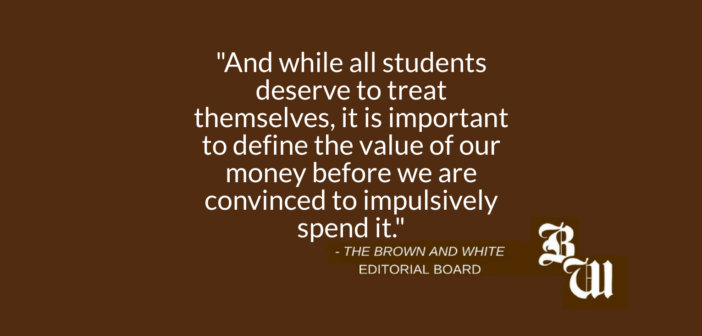$5 dollars for a morning cup of coffee? Swipe.
$15 for a meal out with friends? Swipe.
$50 for concert tickets? Swipe.
With a simple swipe, tap or click, the decision-making process to spend money has been significantly simplified. And as students navigate the limbo between financial dependence and independence, it is important to establish smart budgets and develop sustainable spending habits.
If swipes go unmonitored, even a daily cup of coffee can add up to $400 by the end of the semester. While it is important to indulge and treat ourselves every once in awhile, it is equally as important to acknowledge the value of money and act accordingly.
In 2018, college students held $574 billion in spending power, according to SheerID. Of that sum, $65 billion was spent on food alone.
When it comes to costs that are unavoidable, such as textbooks, the expenses climb as well.
Throughout their time in school, college students can be expected to spend over $3,000 on textbooks and $4,000 in credit cards, personal loans and student debt.
Costs like textbooks, housing and food are nearly unavoidable, but students can regain control of their bank accounts by strategically managing their personal finances.
According to the marketing study, the rise in students’ spending can be linked to “the need to purchase things for status.”
With the presence of social media, it is easy to glorify and share spending, with pictures fancy foods and experiences, for example. And with almost $600 billion in spending power, brands target college students, putting spending at the forefront of our minds.
“Did you forget something in your bag?” clothing stores remind us in our e-mailboxes. Instagram ads provide targeted solutions to our unique needs. Whether it is a skincare product, a restaurant or clothing item, Instagram and other social platforms make it nearly impossible to forget about spending.
And while all students deserve to treat themselves, it is important to define the value of our money before we are convinced to impulsively spend it.
“$5 for a cup of coffee? That’s ridiculous,” students say as the Saxbys line extends out the door on a Monday morning.
Regardless of whether or not students agree with the price, purchases, such as a morning cup of coffee, can become routine. There is nothing inherently wrong with a treat-yourself experience, but the actual cup of coffee can most likely be replicated at home.
For example, a 24-pack of Dunkin Keurig cups costs $13.29. That comes to 55 cents per cup, versus the standard coffee shop’s price of around $3.
Students work hard for their money, and while spending can feel like a reward, budgeting reaffirms the value of that hard-earned cash. Instead of a set of limitations, a budget can serve as a tool to relieve students of the stress that comes from constant spending. When students are in control of where their money goes, they get to decide whether a purchase is necessary, or simply an impulsive decision.
With more experiences and opportunities presented to us every day, students should invest in experiences that repay them. Taking a trip with friends, attending a conference or cooking a home-cooked meal with friends are all ways to both spend money and gain experiences and memories along the way.
It is easy to swipe and move on, but sometimes the most gratifying cups of coffee are those that are home-brewed with friends.





Comment policy
Comments posted to The Brown and White website are reviewed by a moderator before being approved. Incendiary speech or harassing language, including comments targeted at individuals, may be deemed unacceptable and not published. Spam and other soliciting will also be declined.
The Brown and White also reserves the right to not publish entirely anonymous comments.